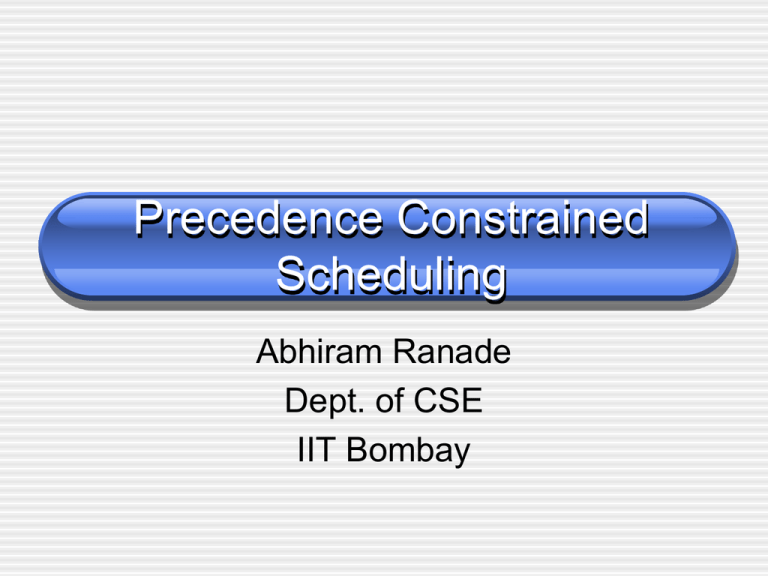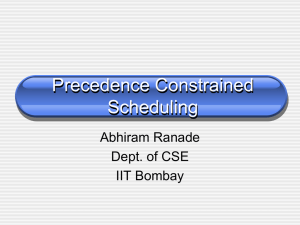Algorithms for Precedence Constrained Scheduling
advertisement

Precedence Constrained Scheduling Abhiram Ranade Dept. of CSE IIT Bombay Input • Directed Acyclic Graph G, #processors p A B E G F H , 3 C D Vertex = unit time task edge (u,v) : Time(u) < Time(v) Output: Schedule Time Processor 1 Processor 2 Processor 3 1 2 3 4 A D E G B F H C Schedule Length, to be minimized Applications • Project management. Vertex = lay • • • • foundation, build walls. Edges: what happens first to what happens later. Processors : Number of workmen. MS Project, others. Our problem: Simplified version. Other applications: Parallel computing. Summary of results • • • • Polytime algorithm when p=2. [Fuiji.. 69] NP-hard for variable p. [LenKan 78] NP-hardness not known for fixed p > 2. Polytime algorithm for trees. [Hu 61] Summary of results - 2 • Any greedy algorithm gives 2 - 1/p approximation. i.e. Schedule of length at most (2 - 1/p) times Optimal length. • [Coffman-Graham 72, Lam-Sethi 77] give 2 - 2/p approximation algorithm. • [Gangal-Ranade 08] give 2 – 7/(3p+1) approximation for p > 3. Outline • Elementary Lower Bound ideas • Elementary algorithm and analysis • Deadline Constraints [GarJoh 76] More complex problem, but generates new ideas. 2 processor optimality, also without deadlines Essentially gives 2 - 2/p approximation • Ideas behind 2 - 7/(3p+1) approximation algorithm Elementary Lower Bounds • To prove optimality of any algorithm, need to show why it cannot be improved, i.e. lower bound on schedule length. • OPT H = Length of longest path in G. • OPT [ N / p ], N = #nodes [ x ] = ceiling(x), smallest integer x. Example: H = 3, [N/p] =[8/3] = 3 Generic Algorithm 1. Assign suitable “priority” to each vertex. 2. Of all “ready” vertices pick one with least priority value, and schedule it at earliest possible time slot. 3. Repeat until done. ready = no predecessors yet unscheduled. earliest possible = after predecessors. Priority Example • Priority(v) = length of longest path from v. • Intuition: If many nodes depend upon me, then I should go first. Proof of 2 approximation • Full (time-) slot: All processors busy • Number of “full” slots N/p • Number of partial slots H. Why? Partial slot: Some processor did not get work. All maximally long paths must shrink. This can happen only H times. • Time N/P + H OPT + OPT = 2 OPT • Improve to 2 - 1/p. Priority? Deadline Constraints [GarJoh 76] • Additional Input: Deadline D(v) : time by which v must be processed. • Need a schedule with p processors in which precedence constraints and deadlines are respected. Deadline Propagation • v has N(d) descendants with deadline d v must itself finish by d - [N(d)/p]. new deadline: d(v) = min( D(v), mind d -[N(d)/p] ) • In what order to calculate? • (u,v) edge d(u) < d(v) • GJ Algo: priority = deadline. Optimal for p=2! Example 4 4 B A . . D C . E . 4 d(A) = 4 - [7/5] = 2 d(B) = min(4-[8/5], 2-[1/5]) = 1 d(C) = …. = 3 d(D) = =2 d(E) = . . . = 0 GJ Deadline Properties • Deadline < 1 : schedule not possible. • Optimal Schedule length Max deadline - Min deadline + 1. Example: 4 0 +1=5 • Load bound : [N/p] = [17/5] = 4 • Longest path: H = 4 • Is this the best lower bound? GJ Longest Path Bound • (u,v) is edge d(u) < d(v) • Path u to v of length H d(u) < d(v) - H • H < Max Deadline – Min Deadline GJ Load Bound • Add a universal parent z • d(z) Max deadline – [Number of descendants with Max deadline/p] • = Max – [N/p] • Min deadline Max – [N/p] Scheduling without external deadlines • Set d(terminal vertices) = k, some number. • Propagate deadlines. m = least deadline. • Schedule from time m using deadlines. Theorem: Algorithm is optimal for p=2. 2 Processor Optimality • v : earliest scheduled vertex not meeting deadline • w : latest scheduled vertex before v scheduled alone. Always exists? Time: 1 2 3 Proc 1: Proc 2: t’ w - t v Nodes in region must be Descendants of w. Region has 2(t-t’)-1nodes with Deadline t-1. • d(w) t’, d(v) t-1 d(w) t-1 - (2(t-t’)-1)/2 = t’-1 Contradiction Remarks • Why does this not work for p > 2? • Algorithm gives 2 - 2/p approximation for even p. More complex proof. Improvements to GJ [GR 09] • Node v has N(d,L) descendants at distance at least L+1 having deadline at least d • Then d(v) mind,L d - L - [N(d,L)/p] Example 4 4 B A . . D C . E . 4 d(A) = 4 - [7/5] = 2 d(B) = min(4-[8/5], 2-[1/5]) = 1 d(C) = …. = 3 d(D) = =2 d(E) = . . . = 0 d(E) 4 – 2 – [12/5] = -1 Max - min + 1 = 6. Optimal! Algorithm [GR 08] • Set d(terminal vertices) = 0 • Propagate deadlines. New rule. • For each v in non-decreasing deadline order: (Rearrange ancestors of v if possible). Schedule v in earliest possible slot, and smallest numbered processor. Rearrange ancestors of v • Suppose t = last slot with ancestors of v. • Suppose vertices in slots t-1,t have same deadline. • Suppose v has < p ancestors in t-1,t. • Then move ancestors of v to slot t-1, move other vertices to slot t. • If slot t is not full, v can be scheduled in t. Analysis Outline • Key part of proof: If algorithm constructs a long schedule, then deadline must drop a lot moving from last column to first. • Max deadline - min deadline + 1 optimal schedule length. • Optimal schedule must also be long, so good approximation factor. How deadline varies in the schedule Time> 1 2 3 …. 1 2 3 . . p uv w Deadline can only increase in first row: d(u) d(v) Deadline can only increase in any column: d(u) d(w) Partial slot rule 1 1 2 3 . . p 1 2 3 ….increasing time. uv w x y - Deadline must increase in first row after a partial slot: d(u) < d(v) … why was not v scheduled earlier? Partial slot rule 2 1 2 3 . . p 1 2 3 ….increasing time. u1 u2 … uk - v Let M denote the number of nodes scheduled after u1..uk. Then d(u1) d(v) - [[M/k]/p] Analysis Details • Count number of 1-slots, 2-slots, full slots • • • • present in schedule. Relate counts to deadline drop, using rules discussed. Find patterns of slot occupancies. Special rules for specific patterns. Combine estimates and take best. Intuition: Easy schedules • Suppose all slots are partial: drop per slot. • Thus total deadline drop = length of schedule. • Optimal! • Suppose all slots are either 1 slots or full slots. • Partial slot rule 2 gives optimality. Intuition: Difficult Schedules • Schedules with mixture of 2-slots and full slots. • Extreme case 1: 2-slots at the beginning, full slots at the end. • Extreme case 2: 2 slots and full slots alternate. • Omitted. See paper. Concluding Remarks • Analysis is complicated, but not much more than 2-2/p analysis of Lam-Sethi. • Algorithm is simpler than CoffmanGraham. • Technique will not work beyond 2 - 3/p. Even getting there is hard.









